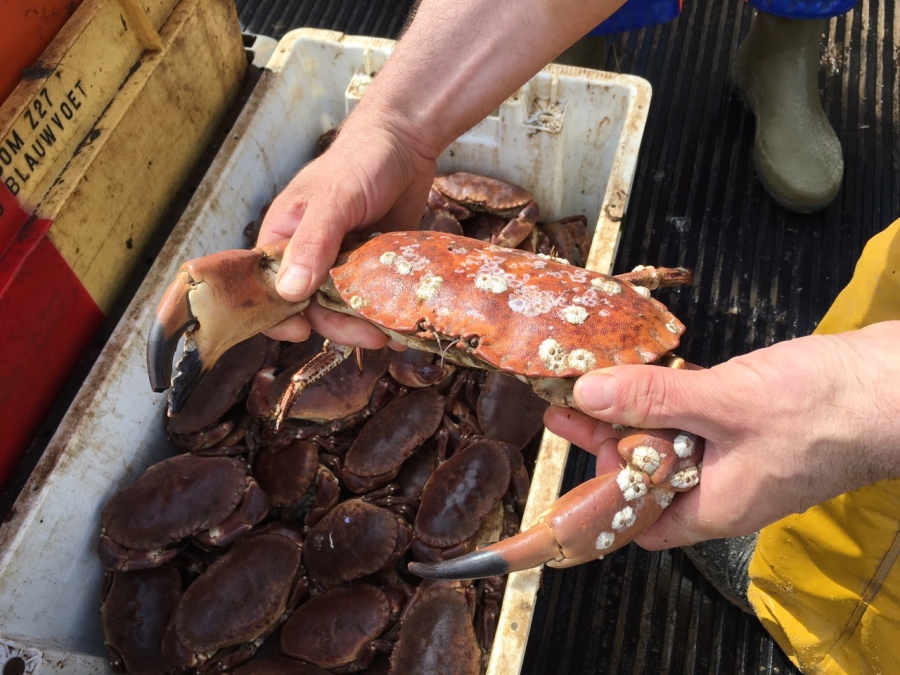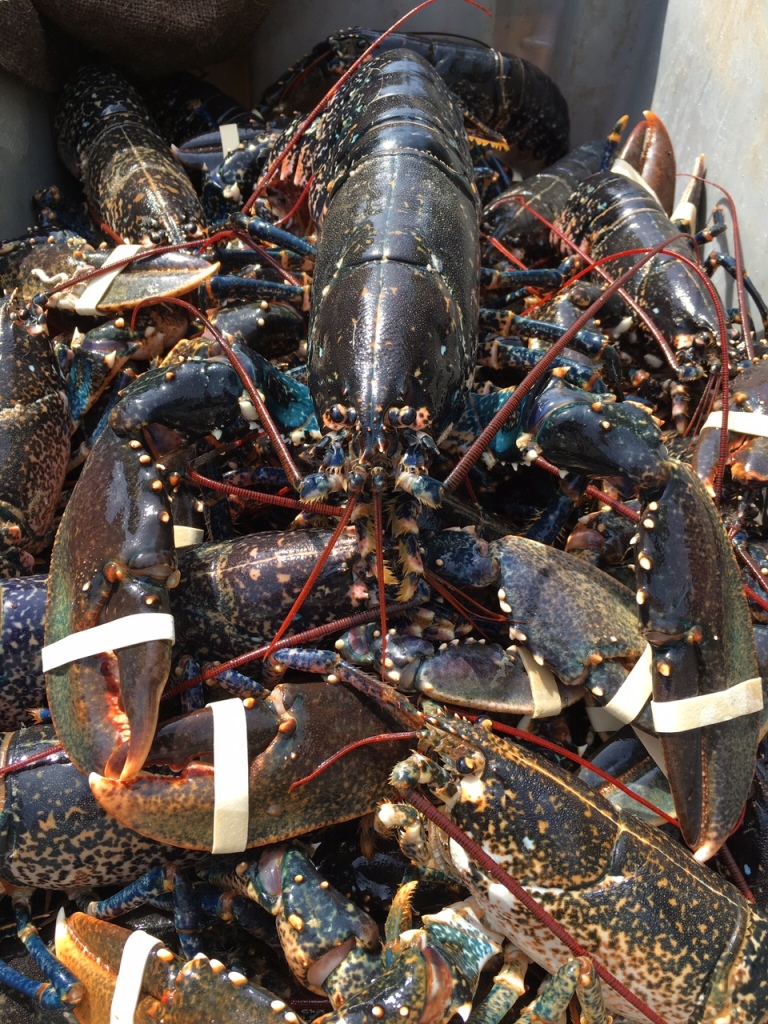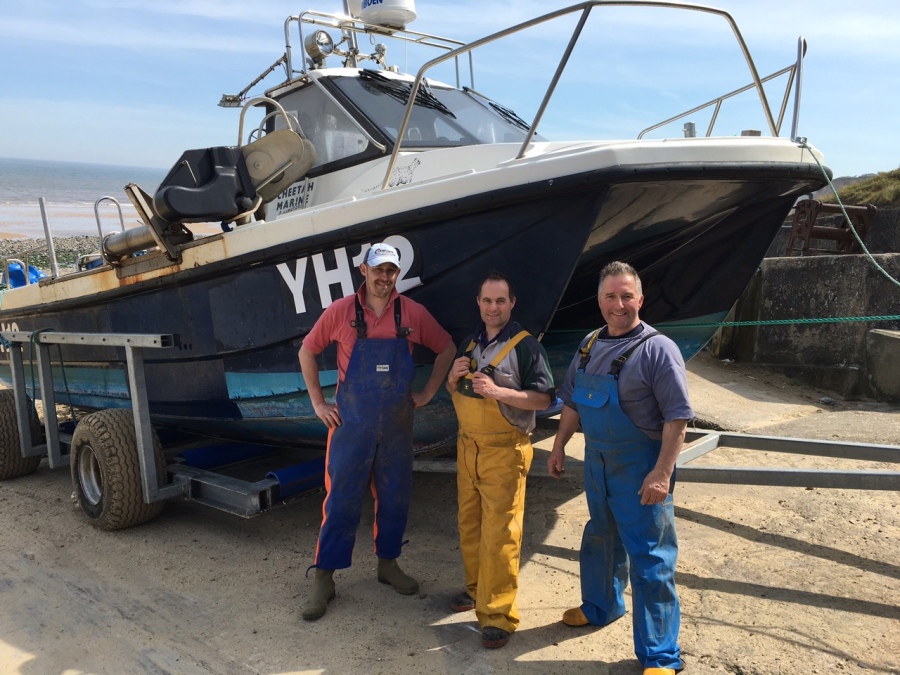Or at least it is when your day job involves harvesting Cromer crabs.
Standing amidst a beautifully picturesque and deserted scene at East Runton, on a deliciously warm and serene May morning, I realise that few places exist, where such a harsh and potentially unforgiving working environment, blends seamlessly with that of carefree seaside holidays, beach walks and the coastal adoration that accompanies these spots for the average visitor. But a workplace it very much is and in eager anticipation of their arrival, I scan the horizon, for signs of David and Simon Bywaters’ “Leeson Lady” YH12, an 8.5 m Cheetah Cat, as she works her way homewards amongst the forest of dahns that delineate the crabbing grounds of this iconic and historic part of the North Norfolk coastline.

Having had the call the night before to advise me of their ETA, I’ve arrived early and as the tide falls away and the morning mist lifts, further down the beach to the east’ard, the familiar silhouette of Cromer Pier and its iconic Lifeboat Station looms out of the haze and only minutes later, the recognisable growl of hefty diesels and a rapidly descending shadow on the slipway, indicate the launch of the RNLI Tamar Class AWB “Lester” the reassuring and melancholy throb of her engines lingering on the air, long after her disappearance into the fret.
After a while another vessel hoves into view and moves back and forth about a half-mile out as she hauls her gear. Gradually she draws closer and I recognise her as the Bywaters’ vessel, trip completed and ready to come ashore, although the state of the tide dictating that she stands off a while longer until an area of sand becomes clear and she can be retrieved without damage.

Crabs predominantly are these two enterprising brothers quarry. Lobsters too, to a certain extent, but its the famous Cromer crab (Cancer pagurus) and its legendary provenance that epitomise this stretch of coastline, with exports of its notably sweet white and brown meat all around the UK featuring on city menus and seaside stalls alike.
Simon jumps off the bow of the now beached vessel and wades back to shore to fetch the tractor and cradle. A process that I envisage is a lot easier and less protracted at high water. I too walk across the sand through the still receding and shallow wavelets that now caress the beach and observe at close quarters, the procedure to winch the “Leeson Lady” onto the cradle and tow her back to the staithe which takes relatively few minutes, in a well-oiled and seamless routine.


Back on the hard, the vessel is secured and the trailer chocked for transferring the catch to the David’s truck and thence onto their unit in the village for processing. This mornings trip has yielded 7 boxes of prime crab and a box of very saleable lobsters from a haul of about half of their gear, which totals around 400 pots fished in shanks of 20. Baited with frozen scad or fresh flatties, the mainly 38 inch “parlour pots” stretch over the ground for up to 9 miles off, on the famous hard bottom chalk reefs that are synonymous with these waters.


“We’re actually in the process of moving to 34 inch pots,” Simon tells me, “They’re lighter and easier to handle and fish just as well with no noticeable drop in yield.” Even with state-of-the-art hydraulic hauling gear, a huge amount of physical human effort is expended each outing, taking its toll on muscles and limbs. I learn too that the investment and switch from a conventional hull to the catamaran, has made a welcome and tangible difference in onboard safety, with the seaworthy work platform of the twin-hulled rig providing much better stability and less inclination to roll than previous boats. Twin 100HP Honda outboards provide the power and have proved very fuel-efficient, in getting the vessel onto the grounds in minimal time.
“We have two speeds, either flat-out or idling,” jokes Simon and I realise that good acceleration is essential, especially when launching stern-first on a beach where seas can be less than forgiving, although you wouldn’t get that impression today.
The catch is duly landed and we make our way back to David’s yard, an old piggery, now purposefully converted into a workshop, stores and processing plant where crabs from their own and about five other Cromer boats are sorted, boiled, dressed and packed destined mainly for wholesale.

“We moved to this site in 1999” David announces and goes on to regale me with more of his family’s history and it’s clear that the Bywaters are a family steeped in the traditional ways of East Anglian inshore fishing. Out of a current family group of five, four are still fishing (three brothers and David’s son) with another brother surrendering a life afloat for that of a bus driver.
“All three boats now fishing out of East Runton are family owned, ” David informs me. “I began fishing here in 1972 and in those days our boats and pots were both wooden.” I learn too, that back then, a very much seasonal crab fishery, was bolstered by equally seasonal effort on the herring and cod with the Bywater clan operating a bigger vessel, longlining out of Lowestoft until only recently.
“The North Sea herring ban in the 1970’s put paid to that fishery,” he continues. “We drifted for them and made good money in the autumn, reverting to longlining for cod in the winter months. When the herring went and quotas for cod were enforced through the Common Fisheries Policy (CFP), then we started fishing for crabs for longer and what was previously a seasonal species, suddenly became a necessary catch all year round.”
A tour of the yard ensues and I’m proudly shown the intake shed, where catches are weighed and sorted, the cookhouse, prep room and lobster holding tanks where a tonne of fish can be held in perfect, environmentally controlled conditions. The whole set up is purpose-built and constructed to hugely exacting standards, where cleanliness and food hygiene are matched by staff safety and efficiency, keeping a careful control on overheads.
“We have 5 staff working here,” David reveals. “Over the course of a year we’re able to process up to 95 tonnes of crab.” That’s a remarkable feat for a relatively small team, when you consider the processes involved from the moment each Brown Crab enters the eye of the pot, attracted by the oily trace of the bait, to when all picked out and resplendently presented in its shell, it becomes what we all know and love as a dressed Cromer crab.


By now it’s become crystal clear to me, that what I’m witnessing here, is yet another inspirational example of pot-to-plate provenance, with added value being the driver in very much the same way that was demonstrated to me last year in Cornwall, during my morning spent with the Dreckly fishermen at Newlyn.
Quality is obviously a byword for the Bywaters. The care taken in handling the product from the deck to the depot is exemplary and with such an identifiable brand, the need to maintain standards at every level is even more crucial.
I ask the brothers what the future holds and what concerns they may have for the fishery. Their answer employs most of the usual suspect concerns and gripes that dominate East coast fisheries from the Humber to the Thames. MPA’s, wind farm activity, dredging, cable laying and invasive leisure activities, all serving to potentially reduce the area that these artisans are allowed to operate in. A message by now only too familiar to me since my first interview with Bill Pinney, nearly two years ago.
The morning draws to a close and as I make my way back to Suffolk, through the now thronging streets of Cromer, I realise what a distinct and categorically important brand the Cromer crab is and that thankfully, its longevity is assured, so long as fishermen like the Bywaters remain guardians of its provenance.

Bywater Shellfish
L-R “Tozzy” (crew), Simon Bywater, David Bywater
It’s Recipe Time……….
Funnily enough, crab doesn’t really feature much on the menus in the Bywater households. An occasional beast will pass their table, but more often than not, they’re just content with seeing their produce get enjoyed by others, who will enthuse and wax lyrical over the delicate and distinctive notes of the dressed-out and finished article.
Personally, (as you’d expect), I adore them and eagerly await their arrival each Spring, like the return of the swallows. A simple salad is probably as good a way to appreciate them as any, but their versatility lends them to recipes of all manner of home grown and international cuisines.
So having had great fun hosting a guest recipe earlier in the year, I have invited the noted, hugely talented and inspirational development chef, Duncan Parsonage to do the business and wield his culinary wand and magic up something special.
He’s not let me down!
Herewith, his take on one of my favourite breakfast recipes, but adding an innovative and spicy touch of the orient, to create an omelette to die for, using these wonderful crustaceans of the North Norfolk coast.
Many thanks for the passion Duncan……… We’ll enjoy!
DUNK’S DESERT ISLAND DISKS
There are two ingredients from natures larder that I would place at the top of my list when/if it came to deciding on my final meal.
Before popping my clogs, I’d savour every last mouthful too.
Before you get any ideas I’m shaking off this mortal coil any time soon- think again! But, I bet you’re intrigued as to what a food fanatic like me would choose eh?
No1- Would be brown Crab, without a shadow of doubt.

I grew up surrounded by water on the Isle of Wight, and have fond memories of picking over the odd cooked Crab with my grandparents as a ‘nipper’. Invariably, the odd piece of shell ended up in the meat, mostly due to the lack of skill exerted by the hammer wielder, but never enough to put me off.
Mixed with a dollop of mustard heavy mayonnaise, a few leaves of peppery watercress, and generously spread between doorstops of bloomer I’m totally in my element. Sold, done, dusted..
April is the month that these beauties from the deep become readily available, and the UK season runs until around November. Always try to buy them alive if possible, and cook them in rapidly boiling, heavily salted water for 15 minutes per kilo. Allow to cool, ideally on a window sill and then place in a fridge once cool enough to handle.
Preparing Crab is time consuming, and a tad fiddly, but very rewarding. Don’t waste a single scrap, with the exception of the gills or ‘dead mans fingers’. If you’re not a brown crab meat fan, stir the richly flavoured meat into risotto or scrambled eggs.

And don’t waste the shells either, you can make the most amazing Crab bisque with them and few other aromatic ingredients. A useful tip is to wrap them up in an old tea-towel and smash them to smithereens with a rolling-pin first!!
As for the dish I’ve created, I’ve kept things simple, delicious and quick to allow the flavour of the Crab to shine.
To feed one hungry, or two modest diners:
1 Cooked and picked brown Crab
4 Whole free range eggs
1 Tablespoon of fish sauce (light soy sauce would be fine)
2 Red birds eye chilli peppers, halved and seeds removed
1 Green long chilli pepper, finely sliced
1 Thumb sized piece of ginger, peeled and finely shredded into strips
1 Cloves garlic, peeled and finely sliced
1 Banana shallot, peeled and finely sliced
1/2 a lime
Vegetable oil for frying
Freshly picked coriander leaves to garnish
Place a wok or deep sided pan onto the heat and add thumbs depth of oil- keep an eye on it!
Whip up the eggs, adding the fish sauce to season and the green chilli, set aside.
When the oil has reached around 150 degrees, deep fry the ginger, shallot, and the red chillies separately until crisp. Drain on kitchen paper.
Allow the heat to recover in the oil before pouring the egg mixture in from a height. This will create a good bubbly texture in the omelette.
Flip the egg ‘raft’ over when the bottom is almost cooked through and continue to fry until thoroughly set.

Remove from the oil and drain on a cake rack for a couple of minutes in a warm place.
To execute the dish, scatter the Crab, garnishes and picked coriander leaves across the top and finish with coriander leaves.
Scoff the lot whilst warm!!

Are you thinking what my No.2 would be?? I’ll give you a clue.. it’s fish.
Have a guess, go on……


Great article, captures the true romance of fishing Mike!
Recipe’s not too shabby either
LikeLike
Cheers mate. Good collaboration! Worked well.
LikeLike
I read your recent trip with the local inshore fishers and am intrigued with the hunt and excitement of being a producer of fine seafood. I did this as a young lad but in today’s world of social media I realise we could both help each other to promote a common cause.
So I wonder I’d there is any merit in me and a local inshore catcher having a bus mans holiday to help promote each other’s industries. I am happy to put a lobster fishermen away with Philip if I could go out on a lobster vessel to help promote each other’s offering and if nothing else promote seafood?
If you think this is a journey worth visiting I’m happy to pay my way in self promoting what we have around our coastline as all promotion is worthwhile.
Let me know your thoughts and ideas on this as a proposal
Regards
Jimmy Buchan
LikeLike
I am very lucky that Dave & Simon are very good friends of mine and I see how hard they work on a regular basis; this is a great article and gives others an insight of the effort that goes into getting the Cromer Crab to the shops, thank you.
LikeLike
Thank you John. Glad you enjoyed!
LikeLike
Dave and Simon,
I’m so pleased that Leesonlady is being put to work so effectively. She was built to my spec as, primarily, a netting boat and I was extremely confident in and proud of her – I cannot praise Cheetah Marine enough. She worked so well and safely in sometimes pretty testing conditions and I was sad to see her leave the Isle of Wight when I retired somewhat earlier than I had envisaged , however she has clearly gone to a good home.
Please look after her and good luck in your future endeavours.
Sincerely, Geoff M
LikeLike
Hi Geoff. I wrote this article on my blog and so David & Simon won’t be able to see your comments. However I’ll pass them on to them. Glad you liked it. Cheers Mike
LikeLike